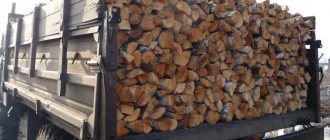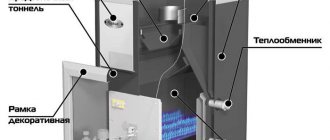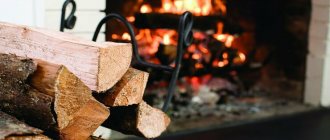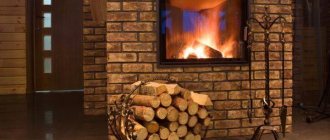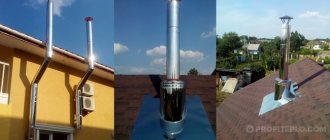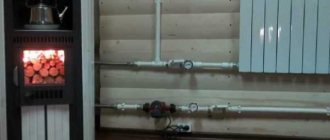It is difficult to overestimate the importance of a chimney for optimal operation of a heating unit. The main task of this device is to remove combustion products from the furnace into the atmosphere. At the same time, the following tasks must be solved:
- Obtaining a uniform thermal regime in the house throughout the day.
- Optimal fuel combustion mode taking into account its economical consumption.
- High-quality removal of combustion products from the furnace and preventing them from entering the residential area of the building.
The solution to this triune problem is ensured by the correct design solution of the thermal unit itself and its high-quality maintenance during operation.
The chimney plays an important role in this case. The effectiveness of this device is determined by several important factors:
- Correct selection of the cross-section and dimensions of the chimney. With a square or rectangular pipe shape, the flow of flue gases, which rises upward in a spiral, forms stagnant zones in the corners. They are the first to form soot deposits. The size of the channel must be one and a half times larger than the combustion hole in the furnace, the minimum dimensions of a square smoke channel are 140x140 millimeters, and the cross-sectional area of a round one must be no less than a square one in the indicated dimensions. The total length of the smoke channel is required to be more than 5 meters. The length of the horizontal section is allowed no more than one meter.
To improve draft, liners are often installed in a smoke channel of square or rectangular cross-section, which to some extent reduces the formation of soot.
- The material from which the chimney is constructed. In this case, two factors are important - the quality of the internal surface of the smoke channel and the thermal conductivity of the material from which it is made. In the first case, the influence of irregularities, in addition to reducing the flow speed, affects the ability to deposit soot. The high thermal conductivity of the pipe material contributes to the rapid cooling of furnace gases, and consequently to increased condensation and deposition of soot on the wall.
- The level of heat losses during operation. Insufficient draft in the chimney negatively affects the degree of fuel combustion, which leads to increased clogging of the smoke channel. And the ignition of soot in a chimney is often tantamount to a natural disaster.
The combination and interaction of the above factors determines the success of the smoke exhaust system.
We deliberately omit a number of rules and important factors in the design of a chimney, concentrating the reader’s attention precisely on the causes and consequences of the formation of soot deposits.
The article describes various methods on how to clean a chimney from soot with your own hands, including without climbing onto the roof.
What is soot and how is it formed
Soot is a product of fuel combustion. It is contained in flue gases in the form of fine, unburned particles. In addition to it, they contain water vapor from the moisture contained in the fuel, carbon monoxide (CO2) and other products of active oxidation of the fuel. At high temperatures, a chemical reaction occurs, as a result of which vapors of hydrochloric and carbonic acids are formed.
Hot smoke condenses on the inner surface as an oily, foul-smelling liquid. Solid unburnt substances enter it, as a result of which, over time, the condensate turns into a tarry sediment. If a number of rules for using a heating unit are not followed, this sediment accumulates quite quickly, reducing the cross-section of the chimney until it closes completely.
It should be noted that condensation requires certain conditions. One of them is the temperature at which it starts. There is even a term for this - “dew point”. Obviously, when the chimney warms up, it will spread higher along the smoke exhaust channel.
A situation may arise when the “dew point” is outside the chimney, and condensation occurs in the open space. This suggests the conclusion that it is impossible to avoid the formation of soot on the walls of the chimney. But a properly designed furnace gas exhaust system significantly increases the frequency of cleaning.
Using powder products
Powder cleaner is used to burn soot formed on the walls of the furnace or furnace. Usually they are burned with wood when heating the stove, this will help prevent the appearance of soot and tar deposits.
- Naphthalene. It is added when the wood has already burned out. It evaporates, and its vapor softens the soot deposit. The obvious disadvantage of this method is the unpleasant smell. Therefore, it should not be used to clean stoves and fireplaces with an open source of fire.
- "Kominichek." Chimney duct cleaner in powder form, 5 sachets of 15 grams in one package. It is recommended to use with a creosote layer thickness of no more than 2 mm. The sachet is placed on smoldering coals and the copper chloride contained in the product loosens the soot layer.
- Blue mixture: copper sulfate - 5 parts;
- saltpeter - 7 parts;
- coal or coke powder - 2 parts.
It is poured onto smoldering coals, and as it evaporates, it softens the soot and it falls off.
About chimney pipe prevention
In the process of development, heating systems became more and more advanced. Some techniques have been experimentally developed to significantly reduce soot formation, such as:
- Chimney insulation. This is done in the following ways: by plastering the surface of brick pipes; covering the outer surface with various roll or slab insulation, followed by installing protection from foil film, metal sheet and other materials; the use of special insulated blocks with ceramic pipes for the installation of a chimney; protective devices to cover the chimney outlet from debris and bird nesting; the use of two-layer “sandwich pipes” made of metal with a layer of insulation.
The purpose of all these measures is to create conditions for rapid heating of the smoke channel, as a result of which the dew point in the process rises higher, until it exits into the environment.
- The largest amount of soot is formed at the bends of the chimney, so no more than one elbow should be used in the design if it is absolutely necessary to change its direction.
- When installing a chimney, it is mandatory to scrape the inner surface in order to reduce the number of irregularities that contribute to the deposition of soot.
- The use of chemical or biological methods for cleaning the internal surface of chimneys during combustion.
Special cases of chimney cleaning
Some chimney cleaning situations require separate consideration.
How to clean a chimney pipe in a private house
The entire process of cleaning a chimney has already been briefly described above. To what has been said, you only need to add that if the smoke channel is severely clogged, the first operation is to punch through the carbon deposits with a core without additional devices. Only after this are brushes of different sizes and designs used sequentially.
When performing work, care should be taken to create safe working conditions.
When working at height, be sure to wear a safety rope
Mechanical methods for removing soot
This is, as a rule, a drastic intervention and is carried out at least once a year at the beginning of the heating season. This is caused by the need not only to remove the soot layer, but also debris caused by the wind. And sometimes you have to get out bird nests that appeared during the period of inactivity of the heating unit.
Mechanical cleaning is carried out from above the pipe using various tools and devices, both manually and using drives from an electric drill or chainsaw.
If the lumen of the pipe is heavily clogged with soot, the initial punching should be done with a clean core to collapse the soot, and then continue with brushes and brushes until the walls are clean.
Before starting work, it is advisable to heat the oven with potato peelings or starch to soften the soot. After the furnace has cooled, its surface must be covered with a wet cloth to prevent soot from entering the room if it collapses; if this happens, cleaning the room will take more than one month. You also need to close the firebox and ash door tightly, and open the damper completely.
The work must be carried out using a roofing ladder, and if necessary, install a fence. Do not take strong medications before going to altitude. Drinking alcohol is strictly prohibited. Otherwise, the chimney sweep risks his health.
All work must be carried out in dry, windless weather during daylight hours.
Watch the video - an easy way to clean
Chimney cleaning, a simple and effective method
When performing chimney cleaning work, the following materials and tools are used:
- Brush for cleaning the chimney lumen. It can be made of plastic or metal 1.5-2 times the size of the channel.
- A flexible cable with a handle for rotation (similar to a plumber's), as well as a fairly strong rope.
- A stiff brush with synthetic bristles on a long handle. It is necessary to provide for its additional extension, because we remember that the length of the chimney is at least 5 meters.
- The weight is metal, in the classic design in the form of a ball. It is attached to a rope below the brush. The size of the ball is selected to be no more than half the size of the chimney opening.
- Metal scraper for removing stubborn soot stains.
Cleaning work must be carried out in the following order:
- Cleaning begins with the use of a brush weight. The initial piercing of the internal lumen is performed. When performing this operation, the device must not be rocked, so as not to damage the walls of the chimney.
- If there is a thick layer of soot, it is better to first work with a metal scraper to remove protrusions and soot stains.
- Finish cleaning should be done with a stiff bristled brush.
- Next, stoves with open fireboxes are cleaned from below, removing soot through the combustion space. The walls are cleaned with a long-hair brush, and finally the chimney is cleaned with a vacuum cleaner.
- Currently, a vacuum chimney cleaner has appeared on the market. Its advantage lies in high-quality cleaning. For the price, this is a tool for professionals.
If, for some reason, you do not have a brush of the required size at your disposal, you can make one on site from a plastic bottle.
To do this, its walls are cut vertically into strips 15-20 millimeters wide so that they bend vertically. This homemade tool works no worse than a standard one. When cleaning a chimney with a chainsaw, it is used as a drive for a traditional tool.
Signs of a clogged chimney
When the flue gas exhaust channel becomes clogged, it will be immediately visible. The main signs of a clogged channel will be the following:
- Deterioration of draft in the stove or fireplace. You need to check the gate, and if it is in the open position, it means that the pipe is overdue for cleaning.
- Gradual attenuation of the flame in the furnace of a heating unit.
- Difficult fuel combustion. If you use dry wood and it doesn't burn, the chimney is most likely to blame.
- Changing the color of the flame in the firebox. You should be especially wary if it has acquired an orange color.
- Strong unpleasant odor. If acrid smoke appears in the room during the combustion process, it means that carbon monoxide (carbon monoxide) is entering it. In this case, the room should be well ventilated, the firebox should be interrupted and measures should be taken to clean the chimney.
The appearance of smoke when the gate is open indicates a lack of draft
What to do if the chimney is clogged
Before the start of the heating season, you must inspect the inside of the chimney for blockages. In the warm season, birds with a nest may settle in it, or debris may appear, blown into the pipe by the wind. To avoid this, the chimney must be equipped at the installation stage with a cap with a mesh that prevents such situations.
In such a case, the house should always have a backup heating unit in the form of a heater or an electric heater built into the heating system.
Having provided yourself with warmth with its help during the cold season, you can carefully consider the situation and think through options for getting out of it.
The presence of draft in the firebox must be checked every time the stove is ignited - the flame must deviate towards the chimney
Features of cleaning stainless steel pipes
Such chimneys are characterized by high quality internal surfaces. This property allows condensate to flow freely down into the condensate collector, from where it is periodically drained and disposed of. The absence of condensation prevents the formation of soot. But carbon deposits, for various reasons, still form and need to be cleaned. This is done as follows:
- Through the hole in the tee, a round brush on a flexible shaft is inserted into the pipes. Carbon deposits are cleaned by rotating the brush from an electric drill. As you move, the drive shaft increases in length to clean the entire length of the pipe.
- If the carbon deposits are persistent, cleaning can be done by burning them out using a blowtorch. To do this, it is necessary to dismantle the chimney and burn it out. At a temperature of 800-900 degrees, sufficient for the intended purpose, even tarnished colors will not appear on a high-quality stainless pipe.
- After cleaning is completed, it is advisable to insulate the chimney riser in order to move the dew point outside the chimney.
You should pay attention to the quality of stainless pipes. The described option is only suitable for austenitic stainless steel. If you were sold pipes made of ferritic or semi-ferritic steel, they most likely will not have the required performance qualities. Determining compliance is simple - normal stainless steel is not magnetic.
The need to clean the inner surface of sandwich pipes does not arise often - condensate flows out of them regularly. But if you suddenly need to carry out this procedure, then you need to use an elongated cylindrical brush on a flexible drive cable that receives rotation from an electric motor.
You can also disassemble the chimney and clean each pipe separately.
Cleaning the chimney from tar deposits
Some fuels form viscous components from condensate and low-flammability creosote components. They are very difficult to fight and difficult to clean.
To reduce the likelihood of the formation of such precipitation, the chemical preparation “Hansa”, which is a crystalline substance, is used. It has a complex composition, one part of which promotes the decomposition of wood into resin and water vapor, and the second part decomposes the resin into flammable components, which burn here. Previously deposited tar stains on the walls of the chimney also decompose into small crystals and fall into the firebox.
"Hansa" is loaded into a burning firebox. At the beginning of the heating season it should be used daily, then periodically. Details on the packaging.
Cleaning a curved chimney from soot
Installing a chimney with a bend is the last solution worth turning to. This is mainly due to the design features of the house. Cleaning a pipe elbow is not difficult if you have taken care in advance of installing inspection hatches during installation.
CHIMNEY CLEANING DEVICE! CHIMNEY CLEANING!
Through them, the pipe can be cleaned without much difficulty. However, it is not advisable to install more than two bends on one chimney. It is mandatory to install a cleaning hatch.
Cleaning the chimney of a gas boiler or water heater
The reason for performing such an operation will be a decrease in traction. This poses a considerable danger, especially when it comes to fitting into an apartment building. In such a situation, not only the residents of one apartment are at risk.
CHIMNEY CLEANING | HOUSE & STREET | MODERN METHOD. HOW TO CLEAN A CHIMNEY
The pipe will not determine the reduction in thrust. The signal may be the “popping” of the igniter. Cleaning the chimney of a gas water heater is similar to cleaning a conventional stove duct.
Tips and tricks
As a result of the long-term use of heating stoves, gas boilers, etc., a number of rules have naturally developed aimed at the efficient use of heating devices. The main ones are:
- It is not recommended to use resinous wood, such as pine, spruce and others, as well as raw wood for heating the stove. In this case, intensive formation of soot and resins is observed.
- The stove must not be heated with scraps of composite materials, including plywood, chipboard, OSB, hardboard and other similar materials. The composite materials used in their manufacture actively clog the chimney with difficult-to-remove sediments on the walls.
- When using coal as fuel (it is suitable for most designs of wood-burning stoves), you need to choose the right grade. One of the best is anthracite of the “nut” fraction, which does not emit a large amount of soot components. Metallurgical coke is a good fuel. It is produced from high-grade anthracite by burning in coke oven batteries. At the same time, all harmful elements burn out, so the coal burns evenly and hotly. Disadvantage: difficult combustion. Therefore, it is better to use a mixture of coke and anthracite. The cheapest and most “harmful” of the fuels of this class are types of gas coal (“goryuchka”). They burn out faster and release a large amount of planting components. Briquetted coal burns well and emits little soot
- In solid fuel stoves, it is strictly not recommended to use household waste as fuel, especially plastic. When heated with garbage, a guarantee of rapid formation of soot deposits on the walls of the pipe.
- When installing a chimney duct, you must strictly fulfill the requirements to ensure maximum draft. This primarily applies to the rules for installing pipes in height.
THREE WAYS TO CLEAN A CHIMNEY FROM SOOT // rustic everyday life
and performance qualities. Now knowing what to heat with in order to clean the chimney, it is easy to keep it in working order at least during the heating season. But cleaning at the beginning of the heating season is still a real and inevitable necessity. However, good luck to you!
How to make a ruff with your own hands
To clean your chimney, you will need a brush. You can buy it or make it yourself. It is made from plastic bottles or a metal brush. The metal brush is not suitable for pipes made of galvanized steel and brick. The brick is coated with clay, and such a brush can damage it. A plastic brush is more versatile and suitable for all types of chimneys.
To make it at home you will need 2 one and a half liter plastic bottles, a metal cable with a diameter of 2 mm, a threaded hook, 2 nuts and 2 washers.
- Cut the bottle crosswise (in half) and cut 1.5-2 cm strips, leaving the top of the bottle intact.
- Make a hole in the lid with a hot nail or wire.
- Assemble on the hook in the following sequence: bottle bottom, 2 necks cut into strips, bottle bottom. Secure everything with 2 nuts and washers.
Add weight down onto the hook using a connecting loop. We attach a cable to the top, it should be at least 2 m. The brush should be 1-2 cm larger than the diameter of the chimney.
When cleaning from below, it is better to use a brush with a telescopic handle.
Why do blockages occur?
The main factor in the formation of plugs in chimneys is emissions from burning wood. Typically, pipes become clogged with soot, tar and carbon monoxide. To reduce the amount of combustion by-products, you need to take a responsible approach to the selection of firewood and know about its characteristics.
Thus, coniferous trees produce a larger amount of resins, but produce less heat. Therefore, they are of little use for space heating. The resin, when released from the firewood, settles on the inner walls of the stove, to which a layer of soot adheres on top.
Also an excellent dirt collector is condensation formed when using undried firewood. It is worth noting that many owners burn household waste in stoves, the waste from which also reduces the clearance in the pipe.
There are also other ways of clogging. For example, in the fall, tree leaves and other debris often get inside. In addition, a layer of soot sometimes flakes off and falls down, blocking the passage.
Folk remedies for combating soot accumulation
How to clean the stove from soot with what is at hand? In addition to the chemical and mechanical method of cleaning the chimney, there are also folk remedies. They were also used by our grandparents. These products are preventive in nature and do not replace annual mechanical cleaning.
- Potato peelings. They are dried and added to the firebox when the furnace is heated. Just adding a couple of handfuls is enough. The starch contained in potatoes softens the soot and it falls off.
- Aspen logs. They have a high combustion temperature and burn plaque in the chimney. This method is not recommended if there is a lot of soot in the chimney or the seal of the smoke channel is broken.
- Salt. It is poured onto dying coals for several days. Salt eats away soot.
- Boiling water. At maximum oven temperature, pour 3 liters of boiling water into the chimney. The steam dislodges the soot like a cork. The remains can be cleaned with salt. But this method is very dangerous and is recommended to be used with caution!
- Walnut shell. It has a high combustion temperature, due to which carbon deposits in the chimney also burn out. It is recommended to heat it once every 7 days. You can use no more than 3 liters of shell at a time.

